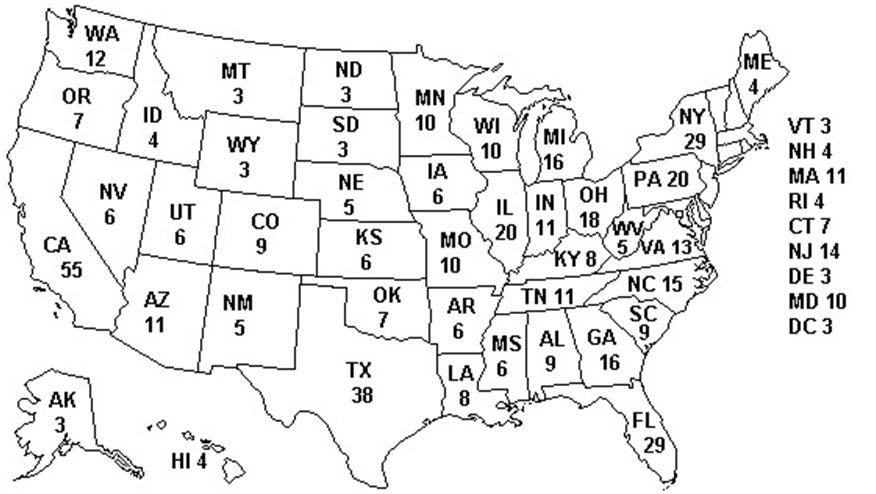Different result between popular vote and electoral vote in the United States Presidential Election has just happened once again. Hillary Clinton gained more popular votes than Donald Trump, the elected president based on the most electoral votes gained in more states. The final result of popular vote for Clinton is 60.576.192 votes (47.7%) against 60.121.004 votes (47.4%) for Trump, however, the final result for electoral vote of the election is in the favor of Donal Trump, 290 to 228.
This is the fourth time in the US presidential election history where the result of popular votes is contradicting the result of electoral votes: (1) In 1876, Rutherford B. Hayes defeated Samuel J. Tilden by 185:184 (popular votes 47.9%:50.9%). (2) In 1888, Benjamin Harrison defeated Grover Cleveland by 233:168 (47.8%:48.6%). (3) In 2000, George W. Bush defeated Al Gore by 271:266 (47.9%:48.4%). In all cases, the election was won by candidate from the Republican Party.
The Electoral College (EC) system in the US presidential election does not emphasize on the principle of “one person, one vote, one value†(OPOVOV). According to the 23rd Amendment of the US Constitution in 1969, this “direct-yet-indirect election†is a compromise between direct election and representative election.
EC is a constitutional body in the US consisted of members from the senate and the congress. Total member of the EC is 538 members from 50 states. Each state has two senators, so in total there are 100 senators. The rest 435 of the EC members come from the congress in each state based on the total population of the state. And the rest 3 are the representatives from District of Columbia or Washington D.C.
Here is the detail:

EC system is basically a plurality system (first past the post) or multiple-leveled one round system. The plurality principle works cumulatively from the polling center, then to the electoral area unit, and then the sum of victory in electoral area unit is compared with the total voters of every candidate to determine the winner of the electoral vote in every area. No matter how slight the vote margin, cumulatively, the candidate with the most popular vote will acquire all electors available in the state (winner-takes-all principle).
Simulation of EC System in Indonesia
In order to better understand the EC system, we can simulate the implementation of such system in the 2014 Indonesia Presidential Election. With such system, EC in Indonesia will be consisted of members come from the Lower House of Parliament (DPD) and the National Parliament (DPR). The total member of EC in Indonesia will be 692 electors. Out of 33 provinces in Indonesia, each province has 4 DPD members, so nationally there will be 132 members. The rest 560 members are the representatives from each province based on the total population in each province.

Based on the final result of the 2014 Presidential Election, here is the result of the electoral vote acquisition if Indonesia implement the EC system:


The Problem of Representation
EC system is basically a representative system, and it has problem regarding the representative aspect of the congress members. In EC system, there are states with total population far below the value of a seat in the congress, however, this state has equal number of elector compared to an area with denser population.
Based on the data on the US population in 2015, we can conclude that the real value of representation for every seat in the congress is 737.348 citizens. With this, we can also conclude which state is under-represented and which is over-represented.
For example, Wyoming has total population of 586,107 people, and it has 3 electors (2 senators and 1 congress member). Meanwhile, Montana has total population of 1,032,949 people but they also repreed by three electors.
If the US want to keep EC system, they would have to rearrange the seat allocation in every electoral area. As a representative system, EC should first and foremost distinguish the concept between area representation and popular representation. The equality principle between states with denser population and states with sparser population has already been fulfilled by the equal number of senator for every state. Therefore, the demand for equality by adding the number of congress member is irrelevant.
If Indonesia want to adopt EC system, Indonesian government would also have to rearrange the seat allocation in every electoral area. If the government want to maintain the current total number of seat in the parliament (560 seats), then this total seat shall be used as the divisor index for the total population of Indonesia. According to the National Census of 2010, total population of Indonesia is 237,031,837 lives, therefore, each seat in the parliament represents 423,271 citizens.
So far, the allocation of seats in the Parliament has not been very representative. There are areas which are under-represented and there are also areas which are over-represented. In 2014 Elections, one seat in West Papua represents 253,618 citizens. Meanwhile in Riau one seat represents 561,899 citizens.
Therefore, it is irrelevant to bring up the Java and non-Java sentiment. All the 560 seats in the Parliament represents citizens, not geographical areas.
In addition, geographical area has been represented by seats in DPD. Every area has equal number of representative seat. Both dense and sparse areas are represented by 4 seats in DPD.
EC Is Prone to Electoral Frauds
Other than being inconsistent with the representation principle, EC system is also prone to frauds and violations. This plurality system in state-based electoral area is prone to intervention and tempering of the election result.
Results of survey or polling may be used as a votes map to show which states have the tiniest vote margin between candidates (swing states). The winner-takes-all system makes these swing states very important because they can very well overturn expectations and a candidate’s initial dominance.
Such phenomena is very well-depicted in the movies Recount (2008). People with color, especially the Afro-Americans, who traditionally vote for the Democratic Party, did not receive proper access to vote during the election. They faced difficulty since voters registration process until the voting process at the polling center.
Akhil Amar and Vikram Amar in “The Electoral College Votes Against Equality†(2004) explains, EC system was originally adopted as an objection to the growing number and influence of the slave (Afro-American) and women. Every state which adopted the abolition policy and allowed women to vote had a much greater number of voters than the state that had not adopted abolition policy.
In addition, EC system is also prone to technical error. The issue regarding “butterfly ballot†in Florida during the 2000 Presidential Election rendered Al Gore had to admit his defeat to George W. Bush, despite the majority of surveys and polling at that time showed Al Gore as victorious to Bush. It’s all because technical issue regarding the ballot design.
The design of the ballot confused many voters. There were cases where a voter select Pat Buchanan on the ballot when he/she was actually intended to vote for Al Gore. As the result, many votes for Gore went to Buchanan. Or, in the case where the voter was aware of the mistake, he/she selected Buchanan and Gore on the same ballot, renders his/her vote invalid.
Other than the “butterfly ballot†issue, there were also a problem regarding “ballot chadâ€. In many cases, voter did not really punch their ballot hard enough to separate the chad with the ballot. This renders the vote invalid when counted with the vote-counting machine. This often happened with senior voters.
In the context of Indonesian 2016 Presidential Election, the election result might also be determined by technical or administrative issue. For example, the election day was not a national holiday, making it difficult for lower-middle class voters to participate.
In EC system, the conversion mechanism of votes into seats in local area has strong influence on national legitimacy of the election result. This is contradictory with the OPOVOV principle where the legitimacy of representation is bases on the accumulation of individual choice.
National legitimacy in EC system is dependent on local context of each state. As the consequence, individual sovereignty is compromised for communal unit of the states.
Election, for better or for worse, is a fundamental element of democracy. The equality as guaranteed by the OPOVOV principle is what distinguish democracy with any other “-cracyâ€. Within democracy, the identity of monarchs, religious leaders, aristocrats, patriarchs, landlord, and any other hierarchical identities are “melted†into one single identity: “the peopleâ€. Therefore, whenever there is an election system that ignores this principle, we should be aware and cautious because it might be a ruse to manipulate democracy into elitism. []
USEP HASAN SADIKIN
 Rumah Pemilu Indonesia Election Portal
Rumah Pemilu Indonesia Election Portal





